HLT 7038 - Change Management in General Motors: A Report
VerifiedAdded on 2023/06/15
|18
|4677
|464
Report
AI Summary
This report provides a detailed analysis of change management in organizations, focusing on the theoretical frameworks and their practical application. It begins by introducing the concept of change management and highlighting its increasing importance in today's global business environment. The report then delves into various change management theories, with a specific emphasis on Burnes’ Change Management Framework, which categorizes changes based on their speed, approach, and continuum. The report further examines the organizational changes implemented by General Motors (GM), analyzing the need for these changes, their implications, and how they align with Burnes’ framework. Ultimately, the report aims to critically evaluate GM's change management process and recommend strategies for future improvements. Desklib provides a platform for students to access this and other solved assignments for academic assistance.
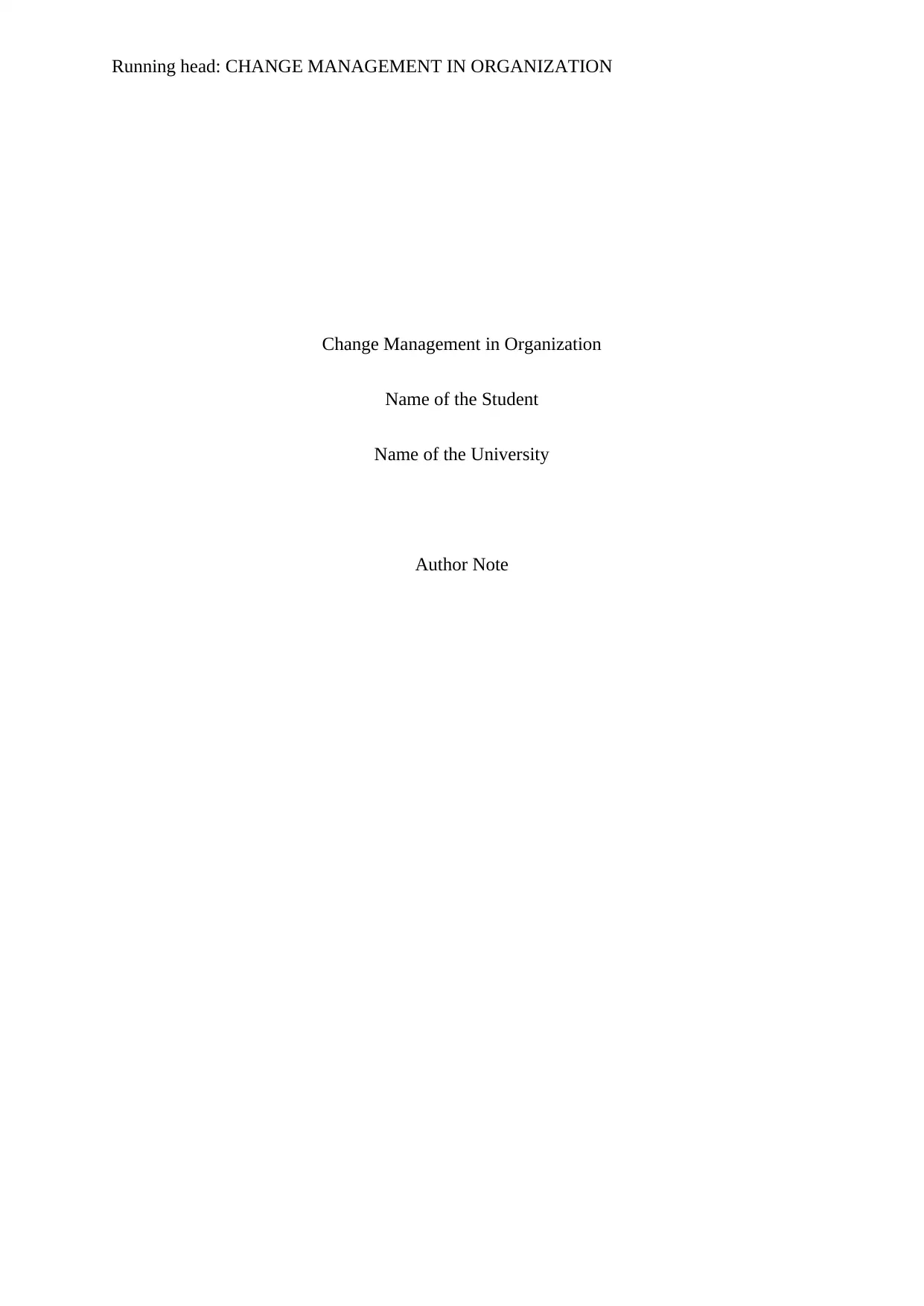
Running head: CHANGE MANAGEMENT IN ORGANIZATION
Change Management in Organization
Name of the Student
Name of the University
Author Note
Change Management in Organization
Name of the Student
Name of the University
Author Note
Paraphrase This Document
Need a fresh take? Get an instant paraphrase of this document with our AI Paraphraser
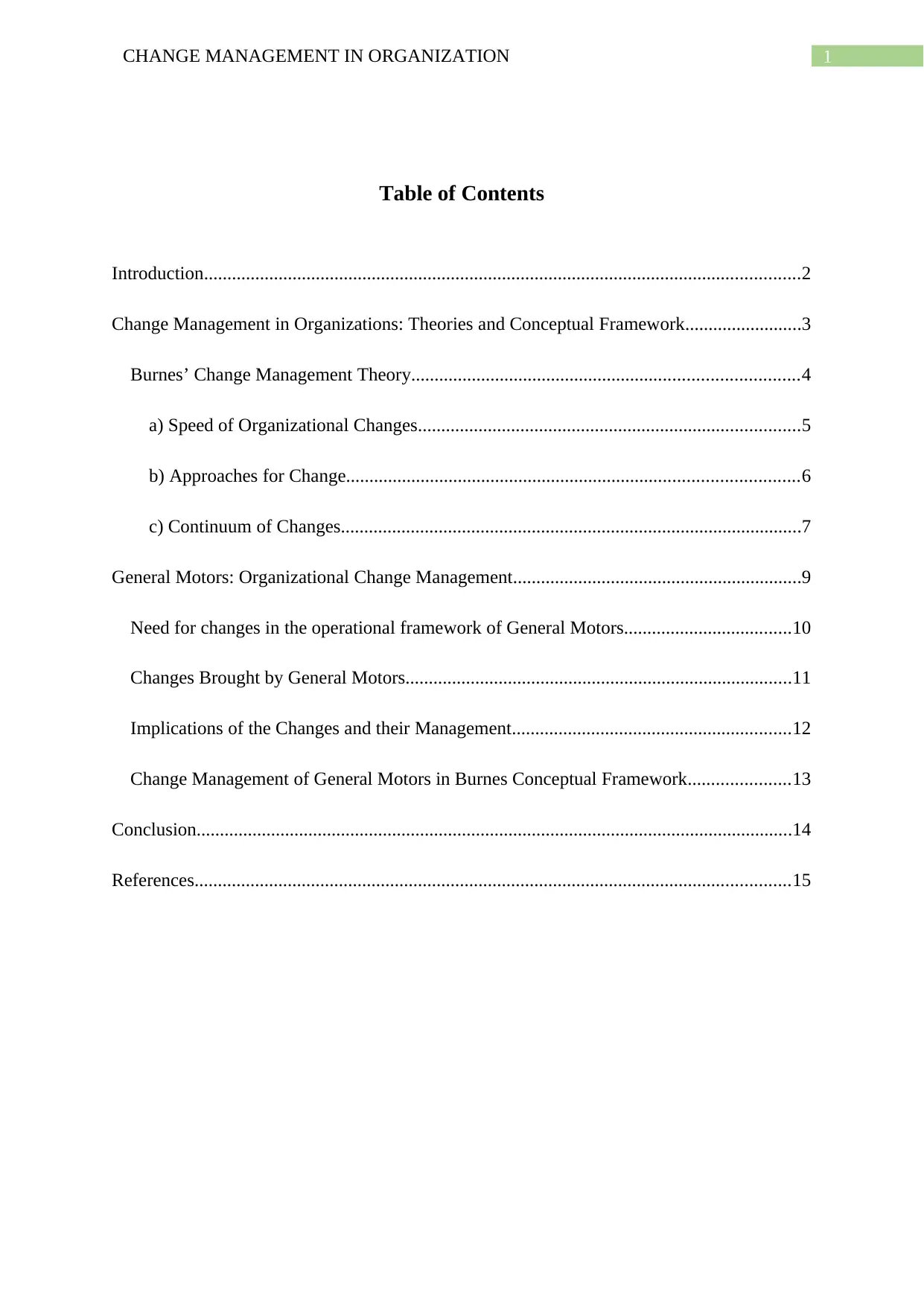
1CHANGE MANAGEMENT IN ORGANIZATION
Table of Contents
Introduction................................................................................................................................2
Change Management in Organizations: Theories and Conceptual Framework.........................3
Burnes’ Change Management Theory...................................................................................4
a) Speed of Organizational Changes..................................................................................5
b) Approaches for Change.................................................................................................6
c) Continuum of Changes...................................................................................................7
General Motors: Organizational Change Management..............................................................9
Need for changes in the operational framework of General Motors....................................10
Changes Brought by General Motors...................................................................................11
Implications of the Changes and their Management............................................................12
Change Management of General Motors in Burnes Conceptual Framework......................13
Conclusion................................................................................................................................14
References................................................................................................................................15
Table of Contents
Introduction................................................................................................................................2
Change Management in Organizations: Theories and Conceptual Framework.........................3
Burnes’ Change Management Theory...................................................................................4
a) Speed of Organizational Changes..................................................................................5
b) Approaches for Change.................................................................................................6
c) Continuum of Changes...................................................................................................7
General Motors: Organizational Change Management..............................................................9
Need for changes in the operational framework of General Motors....................................10
Changes Brought by General Motors...................................................................................11
Implications of the Changes and their Management............................................................12
Change Management of General Motors in Burnes Conceptual Framework......................13
Conclusion................................................................................................................................14
References................................................................................................................................15
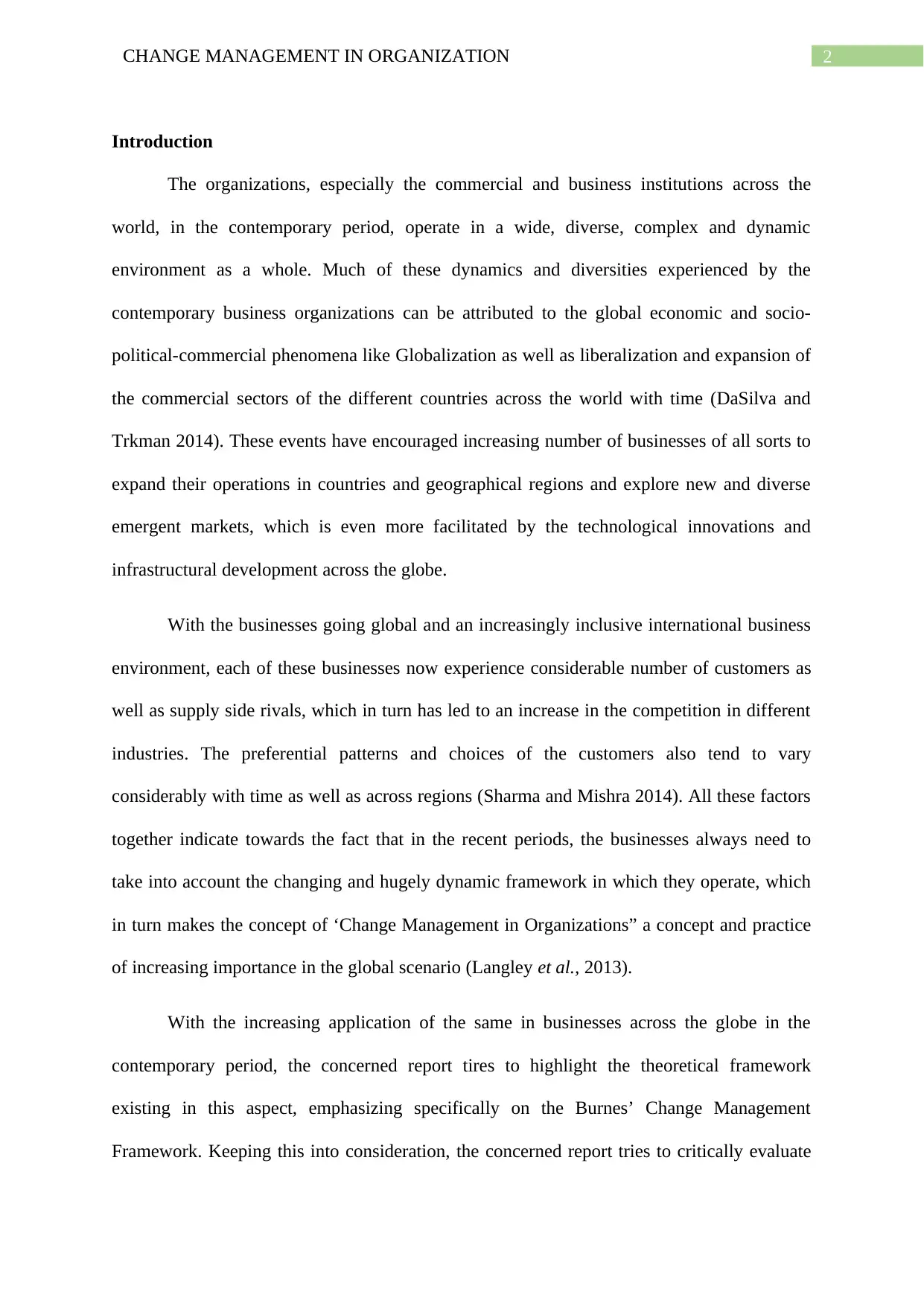
2CHANGE MANAGEMENT IN ORGANIZATION
Introduction
The organizations, especially the commercial and business institutions across the
world, in the contemporary period, operate in a wide, diverse, complex and dynamic
environment as a whole. Much of these dynamics and diversities experienced by the
contemporary business organizations can be attributed to the global economic and socio-
political-commercial phenomena like Globalization as well as liberalization and expansion of
the commercial sectors of the different countries across the world with time (DaSilva and
Trkman 2014). These events have encouraged increasing number of businesses of all sorts to
expand their operations in countries and geographical regions and explore new and diverse
emergent markets, which is even more facilitated by the technological innovations and
infrastructural development across the globe.
With the businesses going global and an increasingly inclusive international business
environment, each of these businesses now experience considerable number of customers as
well as supply side rivals, which in turn has led to an increase in the competition in different
industries. The preferential patterns and choices of the customers also tend to vary
considerably with time as well as across regions (Sharma and Mishra 2014). All these factors
together indicate towards the fact that in the recent periods, the businesses always need to
take into account the changing and hugely dynamic framework in which they operate, which
in turn makes the concept of ‘Change Management in Organizations” a concept and practice
of increasing importance in the global scenario (Langley et al., 2013).
With the increasing application of the same in businesses across the globe in the
contemporary period, the concerned report tires to highlight the theoretical framework
existing in this aspect, emphasizing specifically on the Burnes’ Change Management
Framework. Keeping this into consideration, the concerned report tries to critically evaluate
Introduction
The organizations, especially the commercial and business institutions across the
world, in the contemporary period, operate in a wide, diverse, complex and dynamic
environment as a whole. Much of these dynamics and diversities experienced by the
contemporary business organizations can be attributed to the global economic and socio-
political-commercial phenomena like Globalization as well as liberalization and expansion of
the commercial sectors of the different countries across the world with time (DaSilva and
Trkman 2014). These events have encouraged increasing number of businesses of all sorts to
expand their operations in countries and geographical regions and explore new and diverse
emergent markets, which is even more facilitated by the technological innovations and
infrastructural development across the globe.
With the businesses going global and an increasingly inclusive international business
environment, each of these businesses now experience considerable number of customers as
well as supply side rivals, which in turn has led to an increase in the competition in different
industries. The preferential patterns and choices of the customers also tend to vary
considerably with time as well as across regions (Sharma and Mishra 2014). All these factors
together indicate towards the fact that in the recent periods, the businesses always need to
take into account the changing and hugely dynamic framework in which they operate, which
in turn makes the concept of ‘Change Management in Organizations” a concept and practice
of increasing importance in the global scenario (Langley et al., 2013).
With the increasing application of the same in businesses across the globe in the
contemporary period, the concerned report tires to highlight the theoretical framework
existing in this aspect, emphasizing specifically on the Burnes’ Change Management
Framework. Keeping this into consideration, the concerned report tries to critically evaluate
⊘ This is a preview!⊘
Do you want full access?
Subscribe today to unlock all pages.

Trusted by 1+ million students worldwide
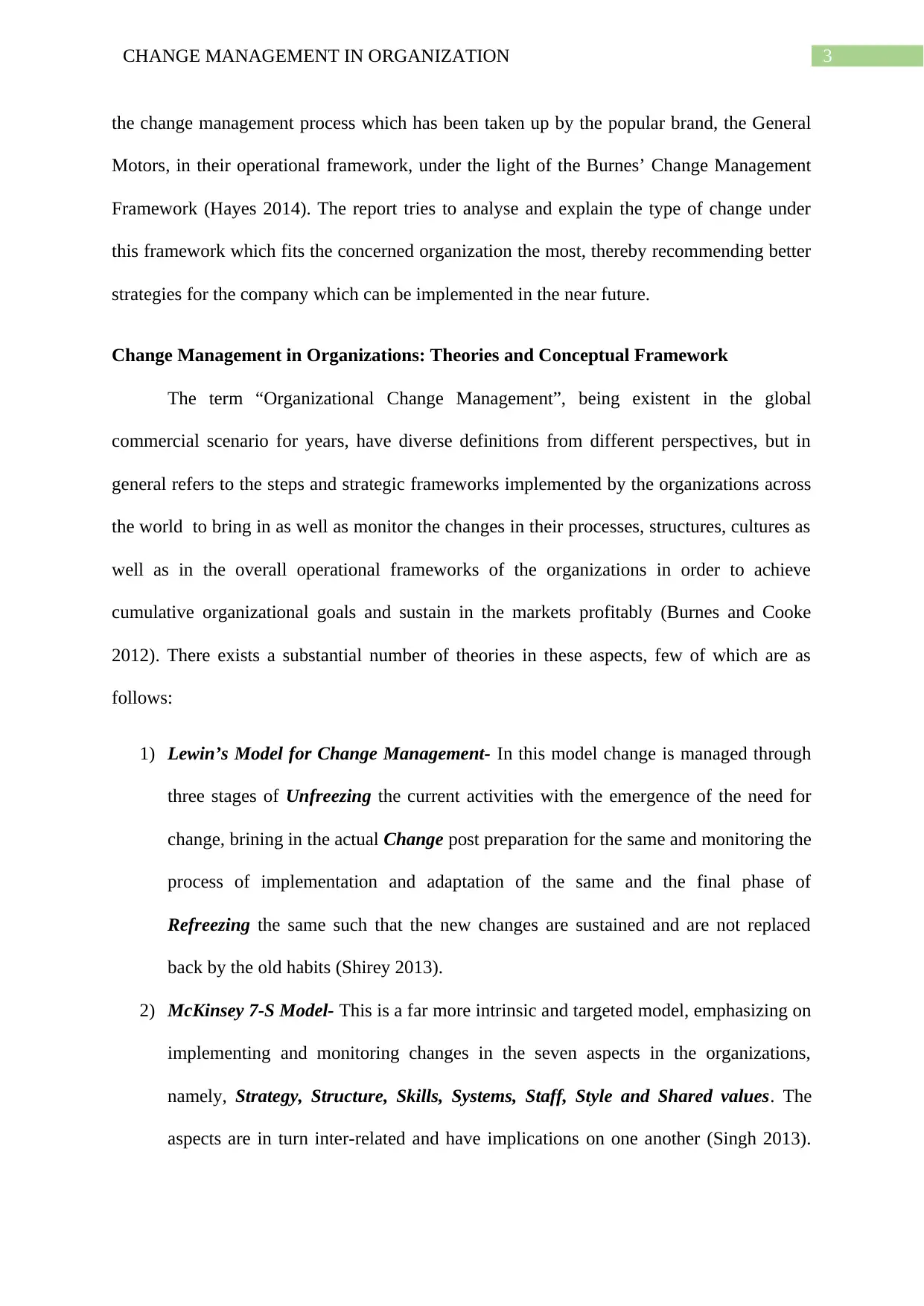
3CHANGE MANAGEMENT IN ORGANIZATION
the change management process which has been taken up by the popular brand, the General
Motors, in their operational framework, under the light of the Burnes’ Change Management
Framework (Hayes 2014). The report tries to analyse and explain the type of change under
this framework which fits the concerned organization the most, thereby recommending better
strategies for the company which can be implemented in the near future.
Change Management in Organizations: Theories and Conceptual Framework
The term “Organizational Change Management”, being existent in the global
commercial scenario for years, have diverse definitions from different perspectives, but in
general refers to the steps and strategic frameworks implemented by the organizations across
the world to bring in as well as monitor the changes in their processes, structures, cultures as
well as in the overall operational frameworks of the organizations in order to achieve
cumulative organizational goals and sustain in the markets profitably (Burnes and Cooke
2012). There exists a substantial number of theories in these aspects, few of which are as
follows:
1) Lewin’s Model for Change Management- In this model change is managed through
three stages of Unfreezing the current activities with the emergence of the need for
change, brining in the actual Change post preparation for the same and monitoring the
process of implementation and adaptation of the same and the final phase of
Refreezing the same such that the new changes are sustained and are not replaced
back by the old habits (Shirey 2013).
2) McKinsey 7-S Model- This is a far more intrinsic and targeted model, emphasizing on
implementing and monitoring changes in the seven aspects in the organizations,
namely, Strategy, Structure, Skills, Systems, Staff, Style and Shared values. The
aspects are in turn inter-related and have implications on one another (Singh 2013).
the change management process which has been taken up by the popular brand, the General
Motors, in their operational framework, under the light of the Burnes’ Change Management
Framework (Hayes 2014). The report tries to analyse and explain the type of change under
this framework which fits the concerned organization the most, thereby recommending better
strategies for the company which can be implemented in the near future.
Change Management in Organizations: Theories and Conceptual Framework
The term “Organizational Change Management”, being existent in the global
commercial scenario for years, have diverse definitions from different perspectives, but in
general refers to the steps and strategic frameworks implemented by the organizations across
the world to bring in as well as monitor the changes in their processes, structures, cultures as
well as in the overall operational frameworks of the organizations in order to achieve
cumulative organizational goals and sustain in the markets profitably (Burnes and Cooke
2012). There exists a substantial number of theories in these aspects, few of which are as
follows:
1) Lewin’s Model for Change Management- In this model change is managed through
three stages of Unfreezing the current activities with the emergence of the need for
change, brining in the actual Change post preparation for the same and monitoring the
process of implementation and adaptation of the same and the final phase of
Refreezing the same such that the new changes are sustained and are not replaced
back by the old habits (Shirey 2013).
2) McKinsey 7-S Model- This is a far more intrinsic and targeted model, emphasizing on
implementing and monitoring changes in the seven aspects in the organizations,
namely, Strategy, Structure, Skills, Systems, Staff, Style and Shared values. The
aspects are in turn inter-related and have implications on one another (Singh 2013).
Paraphrase This Document
Need a fresh take? Get an instant paraphrase of this document with our AI Paraphraser
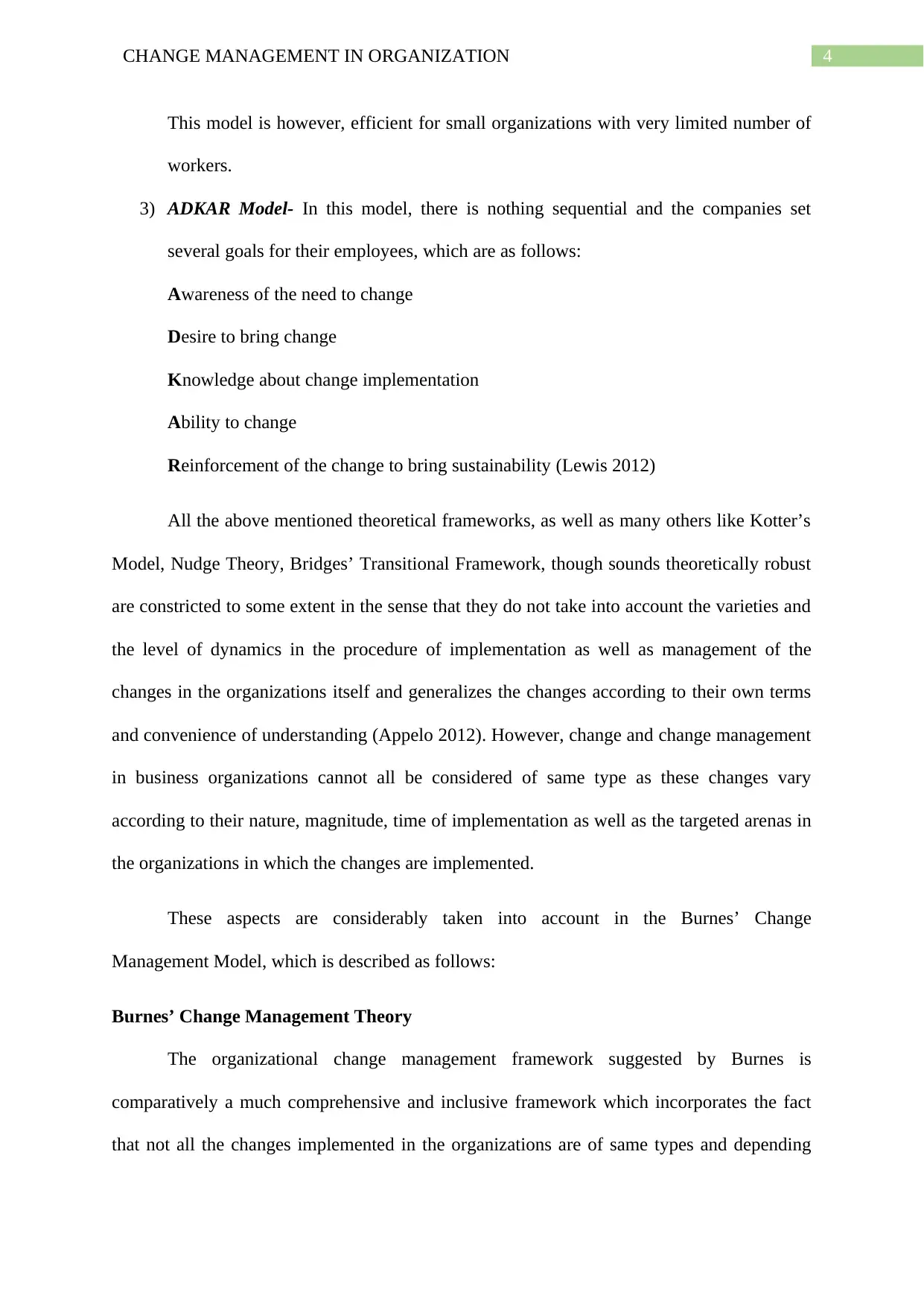
4CHANGE MANAGEMENT IN ORGANIZATION
This model is however, efficient for small organizations with very limited number of
workers.
3) ADKAR Model- In this model, there is nothing sequential and the companies set
several goals for their employees, which are as follows:
Awareness of the need to change
Desire to bring change
Knowledge about change implementation
Ability to change
Reinforcement of the change to bring sustainability (Lewis 2012)
All the above mentioned theoretical frameworks, as well as many others like Kotter’s
Model, Nudge Theory, Bridges’ Transitional Framework, though sounds theoretically robust
are constricted to some extent in the sense that they do not take into account the varieties and
the level of dynamics in the procedure of implementation as well as management of the
changes in the organizations itself and generalizes the changes according to their own terms
and convenience of understanding (Appelo 2012). However, change and change management
in business organizations cannot all be considered of same type as these changes vary
according to their nature, magnitude, time of implementation as well as the targeted arenas in
the organizations in which the changes are implemented.
These aspects are considerably taken into account in the Burnes’ Change
Management Model, which is described as follows:
Burnes’ Change Management Theory
The organizational change management framework suggested by Burnes is
comparatively a much comprehensive and inclusive framework which incorporates the fact
that not all the changes implemented in the organizations are of same types and depending
This model is however, efficient for small organizations with very limited number of
workers.
3) ADKAR Model- In this model, there is nothing sequential and the companies set
several goals for their employees, which are as follows:
Awareness of the need to change
Desire to bring change
Knowledge about change implementation
Ability to change
Reinforcement of the change to bring sustainability (Lewis 2012)
All the above mentioned theoretical frameworks, as well as many others like Kotter’s
Model, Nudge Theory, Bridges’ Transitional Framework, though sounds theoretically robust
are constricted to some extent in the sense that they do not take into account the varieties and
the level of dynamics in the procedure of implementation as well as management of the
changes in the organizations itself and generalizes the changes according to their own terms
and convenience of understanding (Appelo 2012). However, change and change management
in business organizations cannot all be considered of same type as these changes vary
according to their nature, magnitude, time of implementation as well as the targeted arenas in
the organizations in which the changes are implemented.
These aspects are considerably taken into account in the Burnes’ Change
Management Model, which is described as follows:
Burnes’ Change Management Theory
The organizational change management framework suggested by Burnes is
comparatively a much comprehensive and inclusive framework which incorporates the fact
that not all the changes implemented in the organizations are of same types and depending
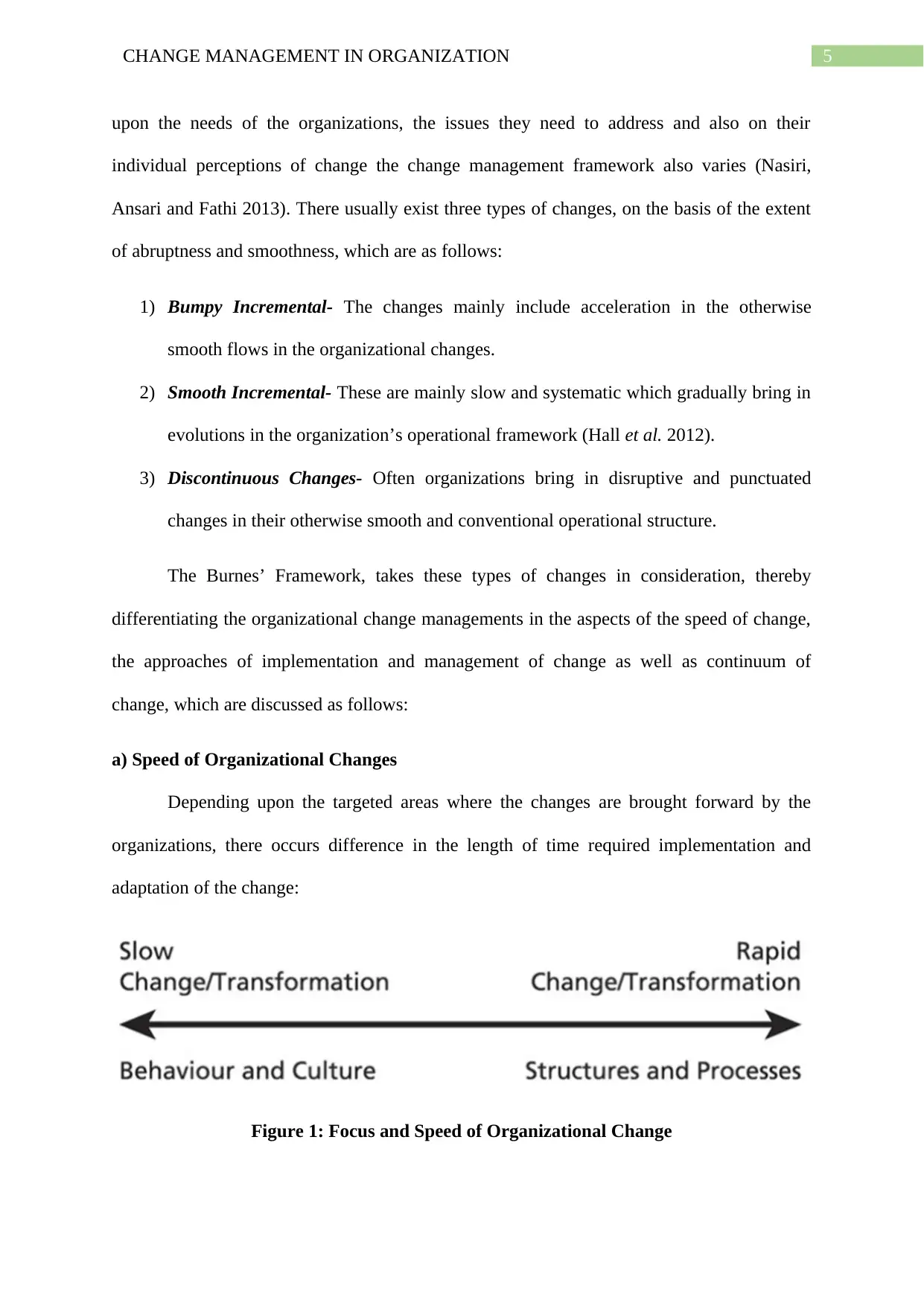
5CHANGE MANAGEMENT IN ORGANIZATION
upon the needs of the organizations, the issues they need to address and also on their
individual perceptions of change the change management framework also varies (Nasiri,
Ansari and Fathi 2013). There usually exist three types of changes, on the basis of the extent
of abruptness and smoothness, which are as follows:
1) Bumpy Incremental- The changes mainly include acceleration in the otherwise
smooth flows in the organizational changes.
2) Smooth Incremental- These are mainly slow and systematic which gradually bring in
evolutions in the organization’s operational framework (Hall et al. 2012).
3) Discontinuous Changes- Often organizations bring in disruptive and punctuated
changes in their otherwise smooth and conventional operational structure.
The Burnes’ Framework, takes these types of changes in consideration, thereby
differentiating the organizational change managements in the aspects of the speed of change,
the approaches of implementation and management of change as well as continuum of
change, which are discussed as follows:
a) Speed of Organizational Changes
Depending upon the targeted areas where the changes are brought forward by the
organizations, there occurs difference in the length of time required implementation and
adaptation of the change:
Figure 1: Focus and Speed of Organizational Change
upon the needs of the organizations, the issues they need to address and also on their
individual perceptions of change the change management framework also varies (Nasiri,
Ansari and Fathi 2013). There usually exist three types of changes, on the basis of the extent
of abruptness and smoothness, which are as follows:
1) Bumpy Incremental- The changes mainly include acceleration in the otherwise
smooth flows in the organizational changes.
2) Smooth Incremental- These are mainly slow and systematic which gradually bring in
evolutions in the organization’s operational framework (Hall et al. 2012).
3) Discontinuous Changes- Often organizations bring in disruptive and punctuated
changes in their otherwise smooth and conventional operational structure.
The Burnes’ Framework, takes these types of changes in consideration, thereby
differentiating the organizational change managements in the aspects of the speed of change,
the approaches of implementation and management of change as well as continuum of
change, which are discussed as follows:
a) Speed of Organizational Changes
Depending upon the targeted areas where the changes are brought forward by the
organizations, there occurs difference in the length of time required implementation and
adaptation of the change:
Figure 1: Focus and Speed of Organizational Change
⊘ This is a preview!⊘
Do you want full access?
Subscribe today to unlock all pages.

Trusted by 1+ million students worldwide
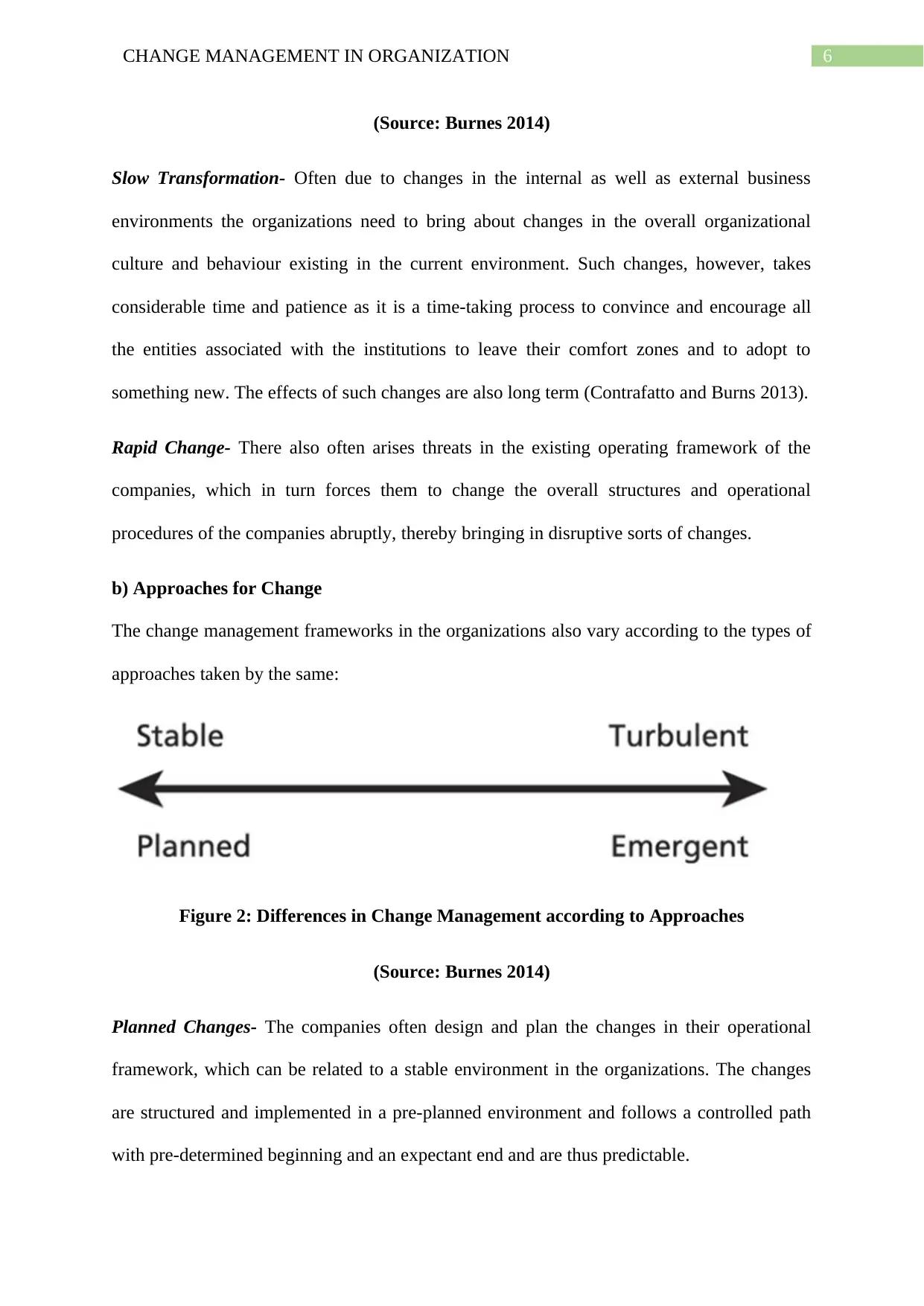
6CHANGE MANAGEMENT IN ORGANIZATION
(Source: Burnes 2014)
Slow Transformation- Often due to changes in the internal as well as external business
environments the organizations need to bring about changes in the overall organizational
culture and behaviour existing in the current environment. Such changes, however, takes
considerable time and patience as it is a time-taking process to convince and encourage all
the entities associated with the institutions to leave their comfort zones and to adopt to
something new. The effects of such changes are also long term (Contrafatto and Burns 2013).
Rapid Change- There also often arises threats in the existing operating framework of the
companies, which in turn forces them to change the overall structures and operational
procedures of the companies abruptly, thereby bringing in disruptive sorts of changes.
b) Approaches for Change
The change management frameworks in the organizations also vary according to the types of
approaches taken by the same:
Figure 2: Differences in Change Management according to Approaches
(Source: Burnes 2014)
Planned Changes- The companies often design and plan the changes in their operational
framework, which can be related to a stable environment in the organizations. The changes
are structured and implemented in a pre-planned environment and follows a controlled path
with pre-determined beginning and an expectant end and are thus predictable.
(Source: Burnes 2014)
Slow Transformation- Often due to changes in the internal as well as external business
environments the organizations need to bring about changes in the overall organizational
culture and behaviour existing in the current environment. Such changes, however, takes
considerable time and patience as it is a time-taking process to convince and encourage all
the entities associated with the institutions to leave their comfort zones and to adopt to
something new. The effects of such changes are also long term (Contrafatto and Burns 2013).
Rapid Change- There also often arises threats in the existing operating framework of the
companies, which in turn forces them to change the overall structures and operational
procedures of the companies abruptly, thereby bringing in disruptive sorts of changes.
b) Approaches for Change
The change management frameworks in the organizations also vary according to the types of
approaches taken by the same:
Figure 2: Differences in Change Management according to Approaches
(Source: Burnes 2014)
Planned Changes- The companies often design and plan the changes in their operational
framework, which can be related to a stable environment in the organizations. The changes
are structured and implemented in a pre-planned environment and follows a controlled path
with pre-determined beginning and an expectant end and are thus predictable.
Paraphrase This Document
Need a fresh take? Get an instant paraphrase of this document with our AI Paraphraser
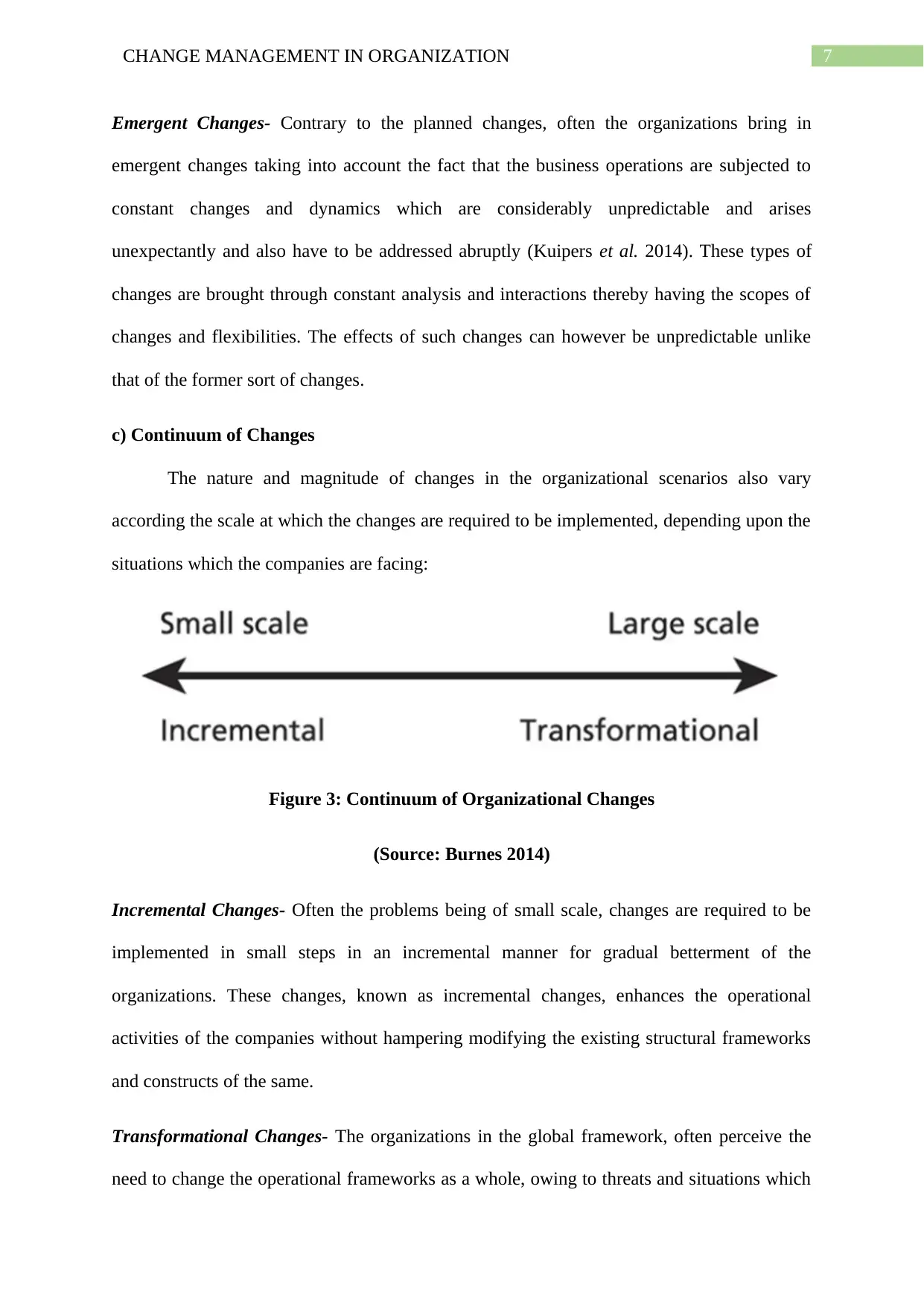
7CHANGE MANAGEMENT IN ORGANIZATION
Emergent Changes- Contrary to the planned changes, often the organizations bring in
emergent changes taking into account the fact that the business operations are subjected to
constant changes and dynamics which are considerably unpredictable and arises
unexpectantly and also have to be addressed abruptly (Kuipers et al. 2014). These types of
changes are brought through constant analysis and interactions thereby having the scopes of
changes and flexibilities. The effects of such changes can however be unpredictable unlike
that of the former sort of changes.
c) Continuum of Changes
The nature and magnitude of changes in the organizational scenarios also vary
according the scale at which the changes are required to be implemented, depending upon the
situations which the companies are facing:
Figure 3: Continuum of Organizational Changes
(Source: Burnes 2014)
Incremental Changes- Often the problems being of small scale, changes are required to be
implemented in small steps in an incremental manner for gradual betterment of the
organizations. These changes, known as incremental changes, enhances the operational
activities of the companies without hampering modifying the existing structural frameworks
and constructs of the same.
Transformational Changes- The organizations in the global framework, often perceive the
need to change the operational frameworks as a whole, owing to threats and situations which
Emergent Changes- Contrary to the planned changes, often the organizations bring in
emergent changes taking into account the fact that the business operations are subjected to
constant changes and dynamics which are considerably unpredictable and arises
unexpectantly and also have to be addressed abruptly (Kuipers et al. 2014). These types of
changes are brought through constant analysis and interactions thereby having the scopes of
changes and flexibilities. The effects of such changes can however be unpredictable unlike
that of the former sort of changes.
c) Continuum of Changes
The nature and magnitude of changes in the organizational scenarios also vary
according the scale at which the changes are required to be implemented, depending upon the
situations which the companies are facing:
Figure 3: Continuum of Organizational Changes
(Source: Burnes 2014)
Incremental Changes- Often the problems being of small scale, changes are required to be
implemented in small steps in an incremental manner for gradual betterment of the
organizations. These changes, known as incremental changes, enhances the operational
activities of the companies without hampering modifying the existing structural frameworks
and constructs of the same.
Transformational Changes- The organizations in the global framework, often perceive the
need to change the operational frameworks as a whole, owing to threats and situations which
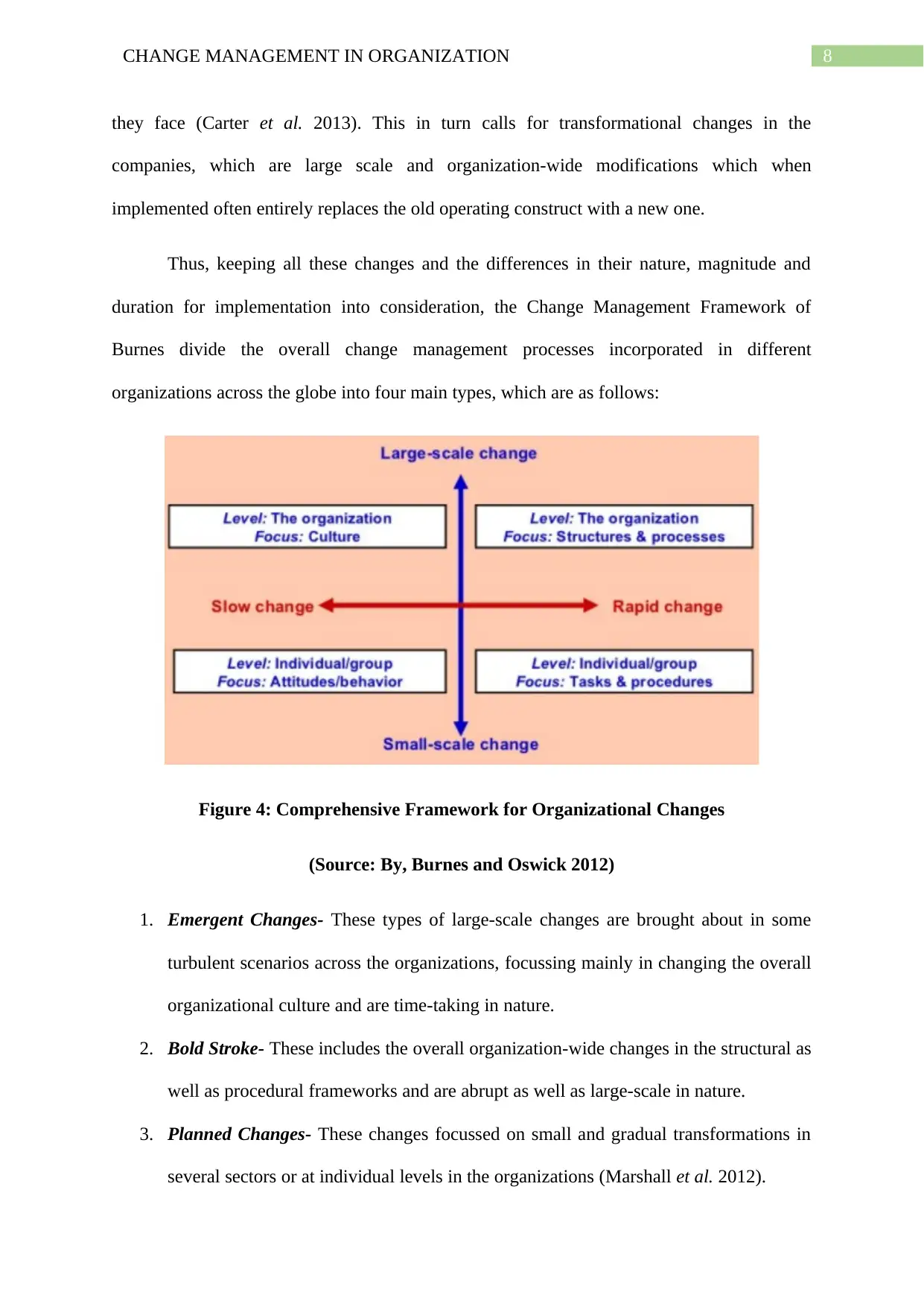
8CHANGE MANAGEMENT IN ORGANIZATION
they face (Carter et al. 2013). This in turn calls for transformational changes in the
companies, which are large scale and organization-wide modifications which when
implemented often entirely replaces the old operating construct with a new one.
Thus, keeping all these changes and the differences in their nature, magnitude and
duration for implementation into consideration, the Change Management Framework of
Burnes divide the overall change management processes incorporated in different
organizations across the globe into four main types, which are as follows:
Figure 4: Comprehensive Framework for Organizational Changes
(Source: By, Burnes and Oswick 2012)
1. Emergent Changes- These types of large-scale changes are brought about in some
turbulent scenarios across the organizations, focussing mainly in changing the overall
organizational culture and are time-taking in nature.
2. Bold Stroke- These includes the overall organization-wide changes in the structural as
well as procedural frameworks and are abrupt as well as large-scale in nature.
3. Planned Changes- These changes focussed on small and gradual transformations in
several sectors or at individual levels in the organizations (Marshall et al. 2012).
they face (Carter et al. 2013). This in turn calls for transformational changes in the
companies, which are large scale and organization-wide modifications which when
implemented often entirely replaces the old operating construct with a new one.
Thus, keeping all these changes and the differences in their nature, magnitude and
duration for implementation into consideration, the Change Management Framework of
Burnes divide the overall change management processes incorporated in different
organizations across the globe into four main types, which are as follows:
Figure 4: Comprehensive Framework for Organizational Changes
(Source: By, Burnes and Oswick 2012)
1. Emergent Changes- These types of large-scale changes are brought about in some
turbulent scenarios across the organizations, focussing mainly in changing the overall
organizational culture and are time-taking in nature.
2. Bold Stroke- These includes the overall organization-wide changes in the structural as
well as procedural frameworks and are abrupt as well as large-scale in nature.
3. Planned Changes- These changes focussed on small and gradual transformations in
several sectors or at individual levels in the organizations (Marshall et al. 2012).
⊘ This is a preview!⊘
Do you want full access?
Subscribe today to unlock all pages.

Trusted by 1+ million students worldwide
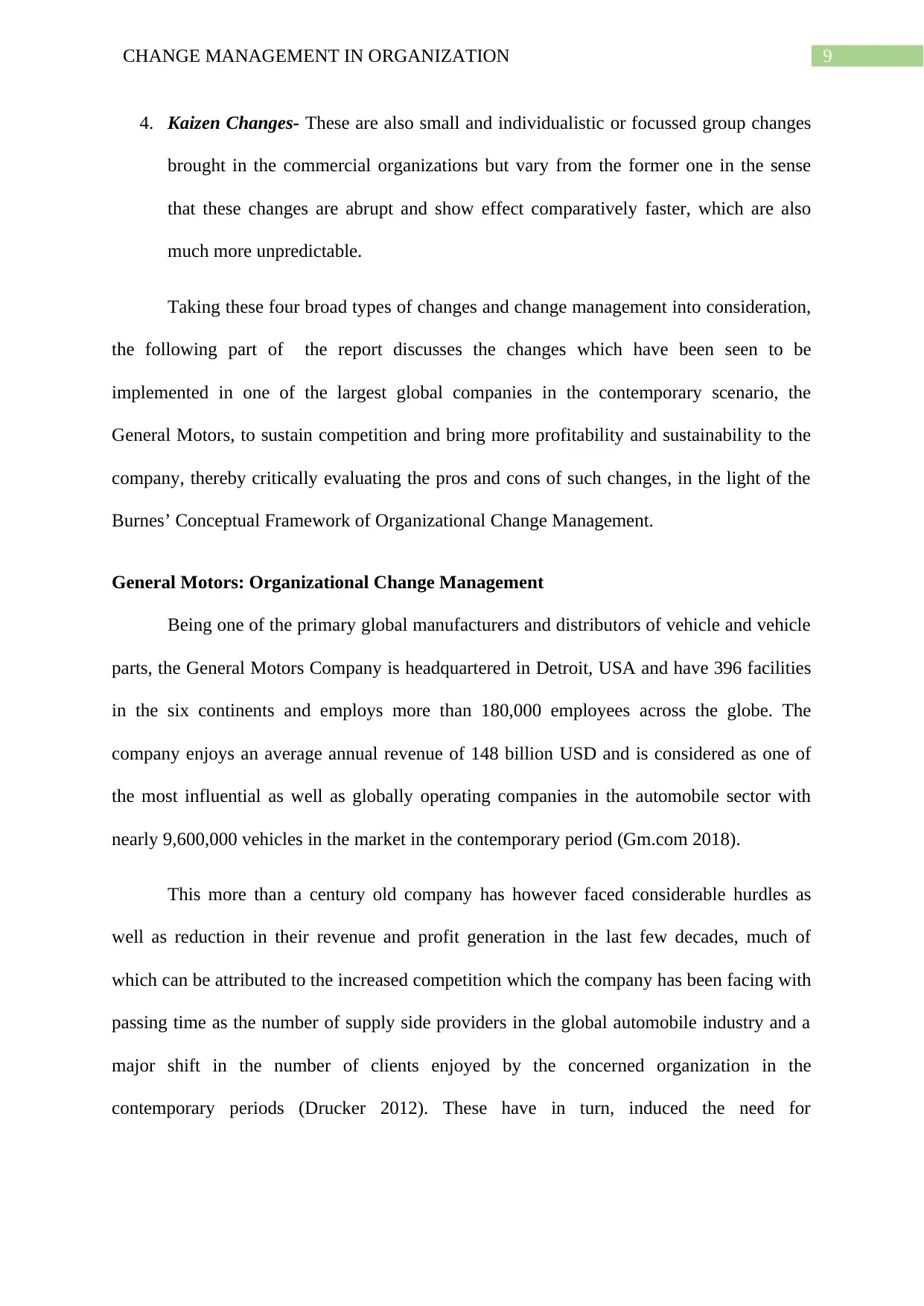
9CHANGE MANAGEMENT IN ORGANIZATION
4. Kaizen Changes- These are also small and individualistic or focussed group changes
brought in the commercial organizations but vary from the former one in the sense
that these changes are abrupt and show effect comparatively faster, which are also
much more unpredictable.
Taking these four broad types of changes and change management into consideration,
the following part of the report discusses the changes which have been seen to be
implemented in one of the largest global companies in the contemporary scenario, the
General Motors, to sustain competition and bring more profitability and sustainability to the
company, thereby critically evaluating the pros and cons of such changes, in the light of the
Burnes’ Conceptual Framework of Organizational Change Management.
General Motors: Organizational Change Management
Being one of the primary global manufacturers and distributors of vehicle and vehicle
parts, the General Motors Company is headquartered in Detroit, USA and have 396 facilities
in the six continents and employs more than 180,000 employees across the globe. The
company enjoys an average annual revenue of 148 billion USD and is considered as one of
the most influential as well as globally operating companies in the automobile sector with
nearly 9,600,000 vehicles in the market in the contemporary period (Gm.com 2018).
This more than a century old company has however faced considerable hurdles as
well as reduction in their revenue and profit generation in the last few decades, much of
which can be attributed to the increased competition which the company has been facing with
passing time as the number of supply side providers in the global automobile industry and a
major shift in the number of clients enjoyed by the concerned organization in the
contemporary periods (Drucker 2012). These have in turn, induced the need for
4. Kaizen Changes- These are also small and individualistic or focussed group changes
brought in the commercial organizations but vary from the former one in the sense
that these changes are abrupt and show effect comparatively faster, which are also
much more unpredictable.
Taking these four broad types of changes and change management into consideration,
the following part of the report discusses the changes which have been seen to be
implemented in one of the largest global companies in the contemporary scenario, the
General Motors, to sustain competition and bring more profitability and sustainability to the
company, thereby critically evaluating the pros and cons of such changes, in the light of the
Burnes’ Conceptual Framework of Organizational Change Management.
General Motors: Organizational Change Management
Being one of the primary global manufacturers and distributors of vehicle and vehicle
parts, the General Motors Company is headquartered in Detroit, USA and have 396 facilities
in the six continents and employs more than 180,000 employees across the globe. The
company enjoys an average annual revenue of 148 billion USD and is considered as one of
the most influential as well as globally operating companies in the automobile sector with
nearly 9,600,000 vehicles in the market in the contemporary period (Gm.com 2018).
This more than a century old company has however faced considerable hurdles as
well as reduction in their revenue and profit generation in the last few decades, much of
which can be attributed to the increased competition which the company has been facing with
passing time as the number of supply side providers in the global automobile industry and a
major shift in the number of clients enjoyed by the concerned organization in the
contemporary periods (Drucker 2012). These have in turn, induced the need for
Paraphrase This Document
Need a fresh take? Get an instant paraphrase of this document with our AI Paraphraser
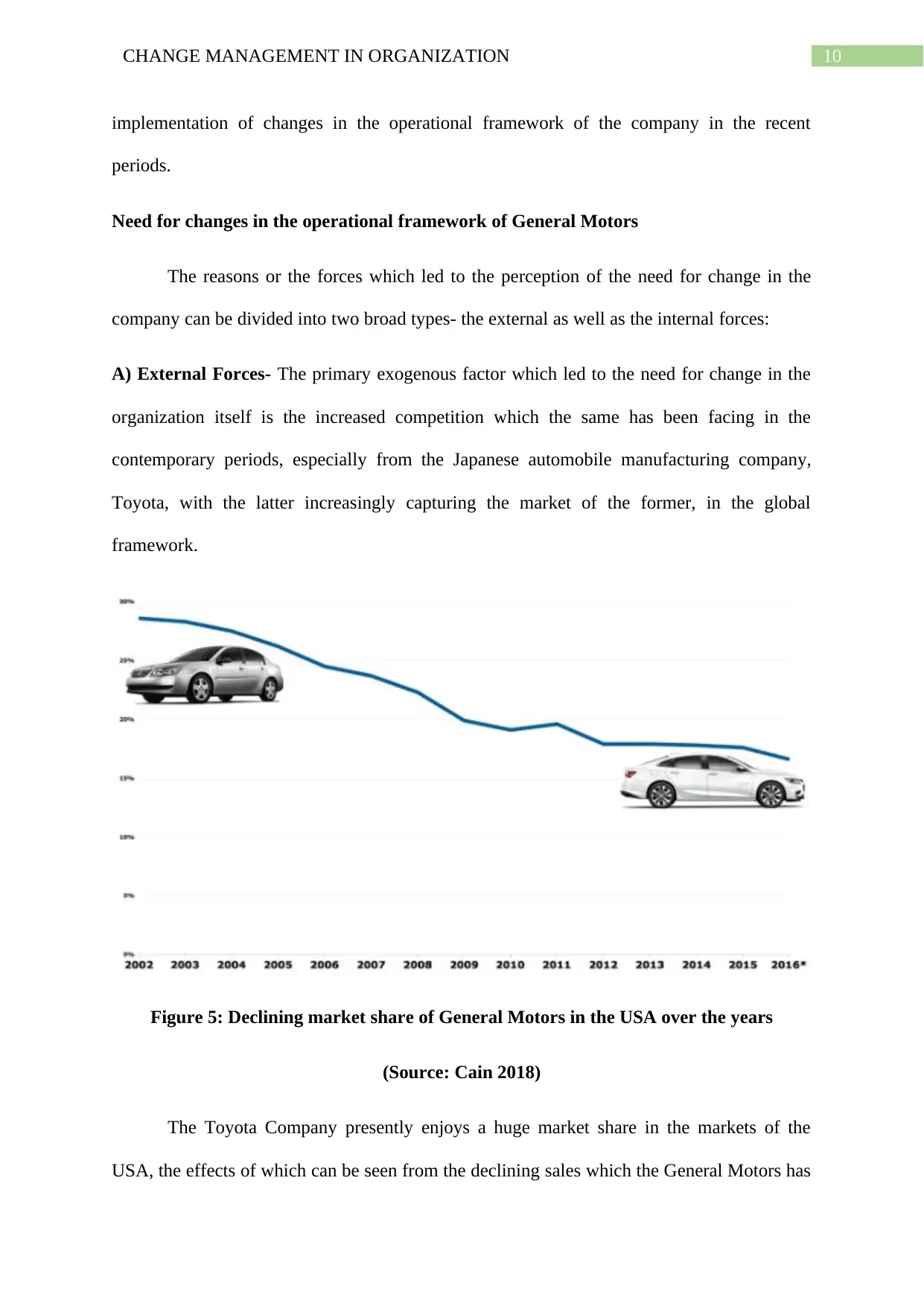
10CHANGE MANAGEMENT IN ORGANIZATION
implementation of changes in the operational framework of the company in the recent
periods.
Need for changes in the operational framework of General Motors
The reasons or the forces which led to the perception of the need for change in the
company can be divided into two broad types- the external as well as the internal forces:
A) External Forces- The primary exogenous factor which led to the need for change in the
organization itself is the increased competition which the same has been facing in the
contemporary periods, especially from the Japanese automobile manufacturing company,
Toyota, with the latter increasingly capturing the market of the former, in the global
framework.
Figure 5: Declining market share of General Motors in the USA over the years
(Source: Cain 2018)
The Toyota Company presently enjoys a huge market share in the markets of the
USA, the effects of which can be seen from the declining sales which the General Motors has
implementation of changes in the operational framework of the company in the recent
periods.
Need for changes in the operational framework of General Motors
The reasons or the forces which led to the perception of the need for change in the
company can be divided into two broad types- the external as well as the internal forces:
A) External Forces- The primary exogenous factor which led to the need for change in the
organization itself is the increased competition which the same has been facing in the
contemporary periods, especially from the Japanese automobile manufacturing company,
Toyota, with the latter increasingly capturing the market of the former, in the global
framework.
Figure 5: Declining market share of General Motors in the USA over the years
(Source: Cain 2018)
The Toyota Company presently enjoys a huge market share in the markets of the
USA, the effects of which can be seen from the declining sales which the General Motors has
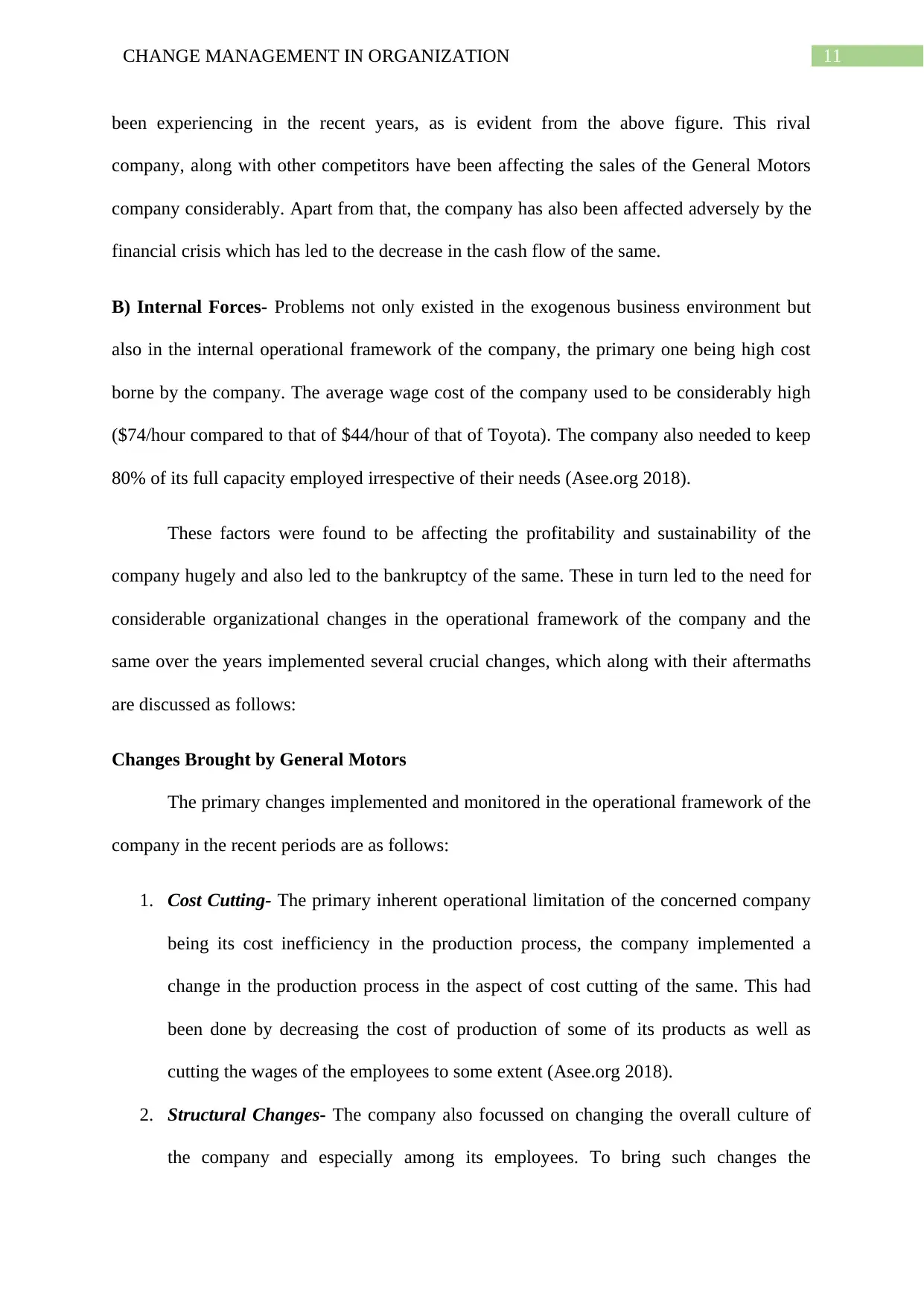
11CHANGE MANAGEMENT IN ORGANIZATION
been experiencing in the recent years, as is evident from the above figure. This rival
company, along with other competitors have been affecting the sales of the General Motors
company considerably. Apart from that, the company has also been affected adversely by the
financial crisis which has led to the decrease in the cash flow of the same.
B) Internal Forces- Problems not only existed in the exogenous business environment but
also in the internal operational framework of the company, the primary one being high cost
borne by the company. The average wage cost of the company used to be considerably high
($74/hour compared to that of $44/hour of that of Toyota). The company also needed to keep
80% of its full capacity employed irrespective of their needs (Asee.org 2018).
These factors were found to be affecting the profitability and sustainability of the
company hugely and also led to the bankruptcy of the same. These in turn led to the need for
considerable organizational changes in the operational framework of the company and the
same over the years implemented several crucial changes, which along with their aftermaths
are discussed as follows:
Changes Brought by General Motors
The primary changes implemented and monitored in the operational framework of the
company in the recent periods are as follows:
1. Cost Cutting- The primary inherent operational limitation of the concerned company
being its cost inefficiency in the production process, the company implemented a
change in the production process in the aspect of cost cutting of the same. This had
been done by decreasing the cost of production of some of its products as well as
cutting the wages of the employees to some extent (Asee.org 2018).
2. Structural Changes- The company also focussed on changing the overall culture of
the company and especially among its employees. To bring such changes the
been experiencing in the recent years, as is evident from the above figure. This rival
company, along with other competitors have been affecting the sales of the General Motors
company considerably. Apart from that, the company has also been affected adversely by the
financial crisis which has led to the decrease in the cash flow of the same.
B) Internal Forces- Problems not only existed in the exogenous business environment but
also in the internal operational framework of the company, the primary one being high cost
borne by the company. The average wage cost of the company used to be considerably high
($74/hour compared to that of $44/hour of that of Toyota). The company also needed to keep
80% of its full capacity employed irrespective of their needs (Asee.org 2018).
These factors were found to be affecting the profitability and sustainability of the
company hugely and also led to the bankruptcy of the same. These in turn led to the need for
considerable organizational changes in the operational framework of the company and the
same over the years implemented several crucial changes, which along with their aftermaths
are discussed as follows:
Changes Brought by General Motors
The primary changes implemented and monitored in the operational framework of the
company in the recent periods are as follows:
1. Cost Cutting- The primary inherent operational limitation of the concerned company
being its cost inefficiency in the production process, the company implemented a
change in the production process in the aspect of cost cutting of the same. This had
been done by decreasing the cost of production of some of its products as well as
cutting the wages of the employees to some extent (Asee.org 2018).
2. Structural Changes- The company also focussed on changing the overall culture of
the company and especially among its employees. To bring such changes the
⊘ This is a preview!⊘
Do you want full access?
Subscribe today to unlock all pages.

Trusted by 1+ million students worldwide
1 out of 18
Related Documents
Your All-in-One AI-Powered Toolkit for Academic Success.
+13062052269
info@desklib.com
Available 24*7 on WhatsApp / Email
![[object Object]](/_next/static/media/star-bottom.7253800d.svg)
Unlock your academic potential
Copyright © 2020–2025 A2Z Services. All Rights Reserved. Developed and managed by ZUCOL.





